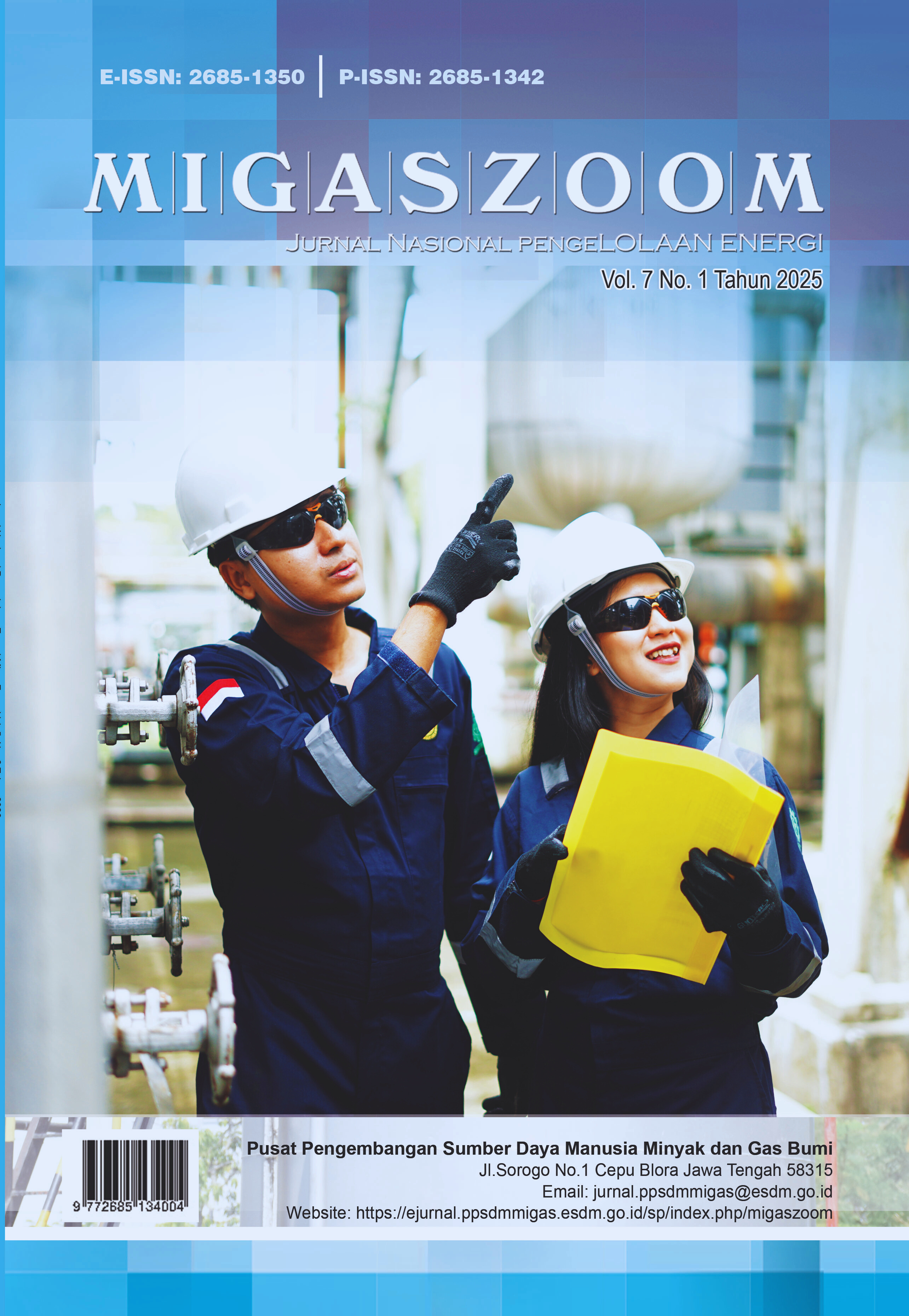Studi Eksperimental Variasi NaOH Dalam Proses Desulfurisasi Pertasol dan Kaitannya dengan Perspektif Fisika Atmosfer
DOI:
https://doi.org/10.37525/mz/2025-1/1050Keywords:
Desulfurisasi, NaOH, Pertasol, Sulfur, TreatingAbstract
Kandungan sulfur dalam bahan bakar fosil seperti Pertasol, merupakan penyumbang utama emisi sulfur dioksida (SO₂) yang berdampak buruk kesehatan manusia, kualitas udara dan keseimbangan atmosfer. Penelitian ini bertujuan untuk mengevaluasi efektivitas desulfurisasi Pertasol jenis CA dan CB menggunakan larutan natrium hidroksida (NaOH) dengan variasi konsentrasi 5–30%, serta mengkaji implikasinya terhadap emisi SO₂ dan nilai Radiative Forcing (RF). Proses desulfurisasi dilakukan secara eksperimental dengan volume bahan bakar tetap 50 mL pada setiap perlakuan, dan dianalisi kandungan sulfur sebelum dan sesudah perlakuan menggunakan Oil Sulfur Analyzer. Hasil menunjukkan bahwa peningkatan konsentrasi NaOH mampu menurunkan kandungan sulfur secara signifikan, dengan efisiensi optimum pada konsentrasi 20–25%. Estimasi emisi SO₂ menurun dari 0,02101 g menjadi 0,01766 g untuk Pertasol CA dan dari 0,04260 g menjadi 0,02075 g untuk Pertasol CB. Penurunan emisi ini diikuti dengan penurunan nilai RF, dari 0,0918 W/m² menjadi 0,0772 W/m² (CA) dan dari 0,1864 W/m² menjadi 0,0909 W/m² (CB), menunjukkan reduksi kontribusi sulfur terhadap ketidakseimbangan energi atmosfer. Proses kimia yang terjadi melibatkan konversi senyawa organosulfur menjadi bentuk garam larut seperti Na₂SO₃ dan Na₂SO₄. Dengan demikian, penggunaan NaOH pada proses desulfurisasi terbukti tidak hanya efektif menurunkan kadar sulfur, tetapi juga berkontribusi dalam upaya mitigasi dampak lingkungan dan perubahan iklim akibat bahan bakar fosil.
References
ASTM (2022) Annual Book of ASTM Standards: Petroleum Products, Lubricants, and Fossil Fuels. West Conshohocken, PA: ASTM International.
Babich, I.V. and Moulijn, J.A. (2003) ‘Science and technology of novel processes for deep desulfurization of oil refinery streams: a review’, Fuel, 82(6), pp. 607–631.
BPP Teknologi (2021) Pedoman Uji Mutu Produk BBM dan BBN. Jakarta: Badan Pengkajian dan Penerapan Teknologi.
BPPT (2020) Manajemen Risiko Bahaya Kebakaran di Industri Energi. Jakarta: BPPT.
BPSDM ESDM (2022) Transformasi Organisasi dan Peran PPSDM Migas dalam Pengembangan SDM Energi Nasional. Jakarta: BPSDM ESDM. Available at: https://bpsdm.esdm.go.id (Accessed: 10 April 2025).
Campos-Martin, J.M., Capel-Sanchez, M.C. and Fierro, J.L.G. (2010) ‘Opportunities for biodiesel and renewable diesel production’, Energy & Environmental Science, 3(5), pp. 292–307.
EPA (2014) Regulations for Fuels and Fuel Additives: Gasoline Sulfur. United States Environmental Protection Agency.
ESDM (2021) Perjalanan Panjang Lembaga Pendidikan Migas di Indonesia. Jakarta: Kementerian Energi dan Sumber Daya Mineral. Available at: https://www.esdm.go.id (Accessed: 17 April 2025).
ESDM (2022) Pusat Pengembangan Sumber Daya Manusia Minyak dan Gas Bumi: Peran dan Fungsi dalam Penguatan SDM Energi Nasional. Jakarta: Sekretariat Jenderal ESDM. Available at: https://www.esdm.go.id/id/beritaunit/ppsdm-migas (Accessed: 17 April 2025).
ESDM (2023) Strategi Pengembangan SDM Energi Berbasis Kompetensi. Jakarta: Kementerian ESDM RI.
Ghaziaskar, H.S. and Pour, M.A. (2010) ‘Optimization of desulfurization conditions for treating petroleum fractions with sodium hydroxide’, Journal of Industrial and Engineering Chemistry, 16(1), pp. 73–77.
Grandey, B. S., Yeo, L. K., Lee, H.-H., & Wang, C. (2018). The equilibrium climate response to sulfur dioxide and carbonaceous aerosol emissions from East and Southeast Asia. Atmospheric Chemistry and Physics, 18, xxx–xxx. https://doi.org/10.5194/acp xx xxx 2018
Gutiérrez, A., Vara, J.L. and Serrano, D.P. (2012) ‘Optimization of oxidative desulfurization processes for diesel fuels: influence of operational variables and evaluation of economic aspects’, Fuel, 95, pp. 578–587.
Huang, D., Zhang, C. and Wang, W. (2010) ‘Desulfurization of gasoline by alkaline extraction’, Fuel Processing Technology, 91(1), pp. 62–68.
Huang, H., Yan, B., Xu, Z., & Zhong, Q. (2018) 'Desulfurization of fuel oils and its impact on atmospheric sulfate aerosol formation: A review', Atmospheric Environment, 188, pp. 1–11.
IFLA (2020) Guidelines for Library Services for Scientific Institutions. The Hague: International Federation of Library Associations.
ILO (2021) Occupational Safety and Health in Oil and Gas Operations. Geneva: International Labour Organization.
IMO (2020) IMO 2020 – cutting sulphur oxide emissions. International Maritime Organization.
IPCC (2021) Climate Change 2021: The Physical Science Basis. Contribution of Working Group I to the Sixth Assessment Report of the Intergovernmental Panel on Climate Change. Cambridge: Cambridge University Press. Available at: https://www.ipcc.ch/report/ar6/wg1/ (Accessed: 10 April 2025).
Jacob, D.J. (1999) Introduction to Atmospheric Chemistry. Princeton: Princeton University Press.
McCabe, W.L., Smith, J.C. and Harriott, P. (2005) Unit Operations of Chemical Engineering. 7th edn. New York: McGraw-Hill.
NASA Earth Observatory. (n.d.). Aerosols and Incoming Sunlight (Direct Effects). Retrieved from https://earthobservatory.nasa.gov/features/Aerosols/page3.php
OSHA (Occupational Safety and Health Administration) (2020) Guidelines for the Safe Handling of Sodium Hydroxide Solutions. Washington D.C.: U.S. Department of Labor.
Permana, A.D., Soeroso, A. and Susilo, D. (2020) ‘Pengaruh Kandungan Sulfur pada Bahan Bakar terhadap Emisi Gas Buang dan Kualitas Udara’, Jurnal Teknologi Lingkungan, 21(3), pp. 215–224. doi:10.22146/jtl.2020.21566.
PPSDM Migas (2020) Sejarah Singkat PPSDM Migas. Cepu: PPSDM Migas. Available at: https://ppsdmmigas.esdm.go.id/sejarah (Accessed: 18 April 2025).
PPSDM Migas (2023) Laporan Kinerja PPSDM Migas 2022. Cepu: PPSDM Migas. Available at: https://ppsdmmigas.esdm.go.id /laporan (Accessed: 17 April 2025).
Rachman, A., Sutrisno, A., & Nurhidayati, D. (2020) 'Penurunan Kadar Sulfur pada Solar Menggunakan Larutan Basa NaOH', Jurnal Energi dan Lingkungan, 16(2), pp. 65–72.
Sari, M.A. and Haryanto, A. (2019) ‘Kajian Desulfurisasi Bahan Bakar Menggunakan Alkali dan Dampaknya terhadap Lingkungan’, Jurnal Rekayasa Kimia dan Lingkungan, 14(1), pp. 12–20. doi:10.23955/rkl.v14i1.14567.
Seinfeld, J.H. and Pandis, S.N. (2016) Atmospheric Chemistry and Physics: From Air Pollution to Climate Change. 3rd edn. Hoboken, NJ: John Wiley & Sons.
Setyawati, R. (2022) ‘Peran Perpustakaan Digital dalam Mendukung Pembelajaran di Sektor Migas’, Jurnal Pustaka Energi, 6(2), pp. 43–50.
Song, C. (2003) ‘An overview of new approaches to deep desulfurization for ultra-clean gasoline, diesel fuel and jet fuel’, Catalysis Today, 86(1–4), pp. 211–263.
Suhardiman, A., Putra, R. and Nugroho, M. (2019) ‘Optimasi Operasi Kilang Mini untuk Pelatihan SDM Migas’, Jurnal Teknologi Energi, 8(1), pp. 15–22.
Wang, H. et al. (2015) ‘Impact of fuel sulfur content on emission characteristics of diesel engines’, Energy Conversion and Management, 91, pp. 233–240.
Wild, M. (2009). Global dimming and brightening: A review. Journal of Geophysical Research, 114(D00D16). https://doi.org/10.1029/2008JD011470
World Health Organization (2021) WHO global air quality guidelines: Particulate matter (PM2.5 and PM10), ozone, nitrogen dioxide, sulfur dioxide and carbon monoxide. Geneva: WHO. Available at: https://www.who.int/publications/i/item/9789240034228 (Accessed: 17 April 2025).
Yuliana, D., Kartika, S. and Nursidik, H. (2021) ‘Implementasi Laboratorium Kilang dalam Pendidikan Vokasional Migas’, Jurnal Rekayasa Energi, 9(3), pp. 89–95.
Zhang, W., Chen, J., Liu, J., and Ma, X. (2019) ‘Recent advances in oxidative and adsorptive desulfurization technologies for fuel oils: a review’, Fuel Processing Technology, 191, pp. 168–182.
Downloads
Published
How to Cite
Issue
Section
License
Copyright (c) 2025 Yuansyah Dhaniar Ramadhan, Arie Realita, Nurdin Nurdin

This work is licensed under a Creative Commons Attribution-NonCommercial-ShareAlike 4.0 International License.
Use, distribution, and adaptation of this work are permitted for non-commercial purposes, under the following conditions:
- Proper attribution must be given to the original author and source (journal), including citation of the title, author name(s), and link to the original version.
- Modifications or adaptations must be released under the same license.
- Commercial use, including republication for financial gain, is not allowed without written permission from the copyright holder.










